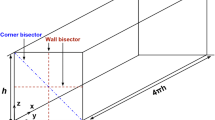Abstract
Detailed measurements including two-component mean velocities (U andV), RMS of turbulent fluctuations (u′ andv′) and turbulent cross-correlation (uv) were made throughout a turn-around duct. Two-component velocity data were obtained using a Laser Doppler Velocimeter. With the aid of a digitized data acquisition system, energy spectra were estimated using a Fast Fourier Transform. Along the outer wall, the flow is affected more than the half across the channel height due to the centrifugal instability. The measured results are consistent with the turbulence production mechanism for stabilizing and destabilizing curved flows. Energy production and dissipation are reduced along the convex wall and amplified along the concave wall. In the quasi-laminar region, turbulent fluctuations and cross-correlations are damped. The mean flow and turbulence structure in this region are influenced mainly by the streamwise pressure gradient rather than curvature. The flow in the downstream part of the turn is dominated by the inertial effect. The turbulent large eddy motions along the concave wall are strongly anisotropic.
Similar content being viewed by others
References
Badrinarayanan, M. A. and Ramjee, A., 1969. “On the Criteria for Reverse Transition in a Two Dimensional Boundary Flow,”J. Fluid Mech., Vol. 35, p. 225.
Barbin, A. R. and Jones, J. B., 1963, “Turbulent Flow in the Inlet Region of a Smooth Pipe,”J. Basic Engineering. Trans. ASME, Vol. 85, p. 29, March.
Barlow, R. S. and Johnston, J. P., 1988, “Structure of Turbulent Boundary Layer on a Concave Surface,”J. Fluid Mech., Vol. 191, p. 137.
Bendat, J. S. and Piersol, A. G., 1971, “Random Data: Analysis and Measurement Procedures,” Wiley-Interscience, A Division of John Wiley & Sons, Inc., New York, NY.
Bradshaw, P., 1969, “The Analogy Between Streamline Curvature and Buoyancy in Turbulent Shear Flow,”J. Fluid Mech., Vol. 36, p. 177.
Brodkey, R. S., Wallace, J. M. and Eckelmann, H., 1974, “Some Properties of Truncated Turbulence Signals in Bounded Shear Flows,”J. Fluid Mech., Vol. 63, p. 209.
Durst, F., Melling, A and Whitelaw, J. H., 1976, “Principles and Practice of Laser Doppler Anemometry,”Academic Press.
Ellis, L. B. and Joubert, P. N., 1974, “Turbulent Shear Flow in a Curved Duct,”J. Fluid Mech., Vol. 62, p. 65.
Eskinazi, S. and Yeh, H., 1956, “An Investigation on Fully Developed Turbulent Flows in a Curved Channel,”J. Aero. Sci., Vol. 23, p. 23.
Gillis, J. C. and Johnston, J. P., 1983, “Turbulent Boundary Layer Flow and Structure on a Convex Wall and Its Redevelopment on a Flat Wall,”J. Fluid Mech., Vol. 135, p. 123.
Hoffmann, P. H., Muck, K. C. and Bradshaw, P., 1985, “The Effect of Concave Surface Curvature on Turbulent Boundary Layers,”J. Fluid Mech., Vol. 161, p. 371.
Hunt, I. A. and Joubert, P.N., 1979, “Effects of Small Streamline Curvature on Turbulent Duct Flow,”J. Fluid Mech., Vol. 91, p. 633.
Klebanoff, P. S., 1954, “Characteristics of Turbulence in a Boundary Layer with Zero Pressure Gradient,”NASA TN 3178.
Kline, S. J. and McClintock, F. A., 1953, “Describing Uncertainties in Single-sample Experiments,”Mechanical Engineering, Vol. 75, p. 3, Jaunary.
Margolis, D. P. and Lumley, J. L., 1965, “Curved Turbulent Mixing Layer,”Phys. of Fluids, Vol. 8, No. 10, p. 1775.
McLaughlin, D. K. and Tiederman, W. G., 1973, “Biasing Error Correction for Individual Realization of Laser Anemometer Measurements in Turbulent Flow,”Phys. of Fluids, Vol. 16, No. 12.
Meroney, R. N. and Bradshaw, P., 1975, “Turbulent Boundary Layer Growth over a Longitudinally Curved Surface,”AIAA J., Vol. 13, p. 1448.
Muck, K. C., Hoffmann, P. H. and Bradshaw, P., 1985, “The Effect of Convex Surface Curvature on Turbulent Boundary Layers,”J. Fluid Mech., Vol. 161, p. 347.
Ramaprian, B. R. and Shivaprasad, B. G., 1978, “The Structure of Turbulent Boundary Layers Along Mildly Curved Surfaces,”J. Fluid Mech., Vol. 85, p. 273.
Smits, A. J., Young, S. T. B. and Bradshaw, P., 1979, “The Effect of Short Regions of High Surface Curvature on Turbulent Boundary Layers,”J. Fluids Mech., Vol. 94, p. 209.
So, R. M. C. and Mellor, G. L., 1972, “An Experimental Investigation of Turbulent Boundary Layers Along Curved Surfaces,”NASA CR-1940.
Tanaka, H. and Yabuki, H., 1986, “Laminarization and Reversion to Turbulence of Low Re. Flow Through a Converging to Constant Area Duct,”J. Fluids Eng., Vol. 108, p. 325.
Wattendorf, F. L., 1935, “A Study of the Effect of Curvature on Fully Developed Turbulent Flow,”Pro. Roy. Soc., A 148, p. 565.
Wilcken, H., 1930, “Effect of Curved Surfaces on Turbulent Boundary Layers,”NASA TT-F-11421.
Author information
Authors and Affiliations
Rights and permissions
About this article
Cite this article
Shin, JC. Experiments on the turbulent shear flow in a turn-around duct(II)—The structure of turbulence. KSME Journal 8, 460–474 (1994). https://doi.org/10.1007/BF02944717
Received:
Issue Date:
DOI: https://doi.org/10.1007/BF02944717




